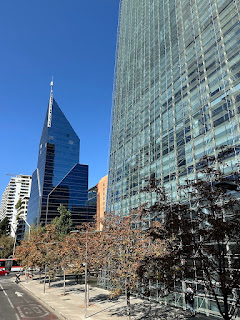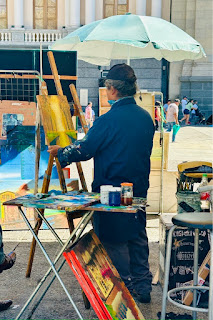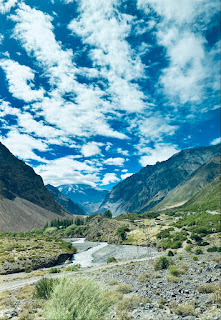You can't miss it.
The Costanera is definitely the tallest thing around, by far.
That's where we started our day today.
FROM WIKIPEDIA: https://www.viator.com/tours/Santiago/Santiago-Hop-On-Hop-Off-Tour/d713-5249HOHO
Costanera Center The Costanera Center is a complex that combines an experience of modernity and entertainment. With the tallest building in Latin America at 300 meters high, this imposing construction offers endless possibilities that start with its wide range of products in the largest mall in Chile, where some of the most important brands in the world are housed. world. In addition to its wide culinary offering, it has a terrace and a viewing point, the Sky Costanera, which allows you to appreciate the city with privileged views. The venue also has a cinema and its surroundings, with the maximum expression of modernity and progress, in front of the new financial district of the city, also known as Sanhattan.

We are big fans of the Hop On Hop Off buses in big cities. It takes us exactly where we need to go, give us information about the attractions, and save us from the stress of driving or taking public transportation. All of course, when we don't have too much time to explore the city. In our case, we had one day - the very last one of our vacation - to visit the main attractions of Santiago. And we can always get off and explore the area on our own, walking.
What a beautiful day!
Our impressions of Chile's capital: a beautiful, modern, clean, friendly and orderly city.
It's also a bit too dry for me. My noise and throat are feeling it for weeks after.
FROM WIKIPEDIA: https://en.wikipedia.org/wiki/Santiago
Santiago, also known as Santiago de Chile, is the capital and largest city of Chile and one of the largest cities in the Americas. It is located in the country's central valley and is the center of the Santiago Metropolitan Region, which has a population of 7 million, representing 40% of Chile's total population. Most of the city is situated between 500–650 m (1,640–2,133 ft) above sea level.
Founded in 1541 by the Spanish conquistador Pedro de Valdivia, Santiago has served as the capital city of Chile since colonial times. The city has a downtown core of 19th-century neoclassical architecture and winding side-streets featuring a mix of art deco, neo-gothic, and other styles. Santiago's cityscape is defined by several stand-alone hills and the fast-flowing Mapocho River, which is lined by parks such as Parque Forestal and Balmaceda Park. The Andes Mountains can be seen from most parts of the city and contribute to a smog problem, particularly during winter, due to the lack of rain. The outskirts of the city are surrounded by vineyards, and Santiago is within an hour's drive of both the mountains and the Pacific Ocean.
Santiago is the political and financial center of Chile and is home to the regional headquarters of many multinational corporations. The Chilean government's executive and judiciary branches are based in Santiago, while the Congress mostly meets in nearby Valparaíso.

Check out this architecture! Wow!
So clean and organized!
FROM WIKIPEDIA: https://www.viator.com/tours/Santiago/Santiago-Hop-On-Hop-Off-Tour/d713-5249HOHO
Los Conquistadores & Pedro de Valdivia Norte Cable Car This is the closest stop to the entrance to the Santiago Metropolitan Park and Cable Car. It is only a 5-minute walk to enjoy these entertaining attractions, such as seeing Santiago from above on the Cable Car and reaching the top of San Cristóbal Hill. On the way to the park you can visit the Sculpture Park, an outdoor area with more than 30 sculptures by prominent Chilean artists. Also in the sector is the historic Casona “Lo Contador”, a beautiful building with Spanish influences from the late 18th century, which today is occupied by the Campus of Architecture, Design and Urban Studies of the Catholic University.
Without a doubt, the cable car ride was the highlight of the day.
The view from up there is amazing, a 360 degrees of the Capital City and the mountains surrounding it.
Sticking out, the Costanera, of course!
We could even see some glaciers.
On the top of the hill there is a small chapel.
That's the Sanctuary of the Immaculate Conception.

FROM: https://www.gpsmycity.com/attractions/sanctuary-on-san-cristobal-hill-19354.html#:~:text=The%20Sanctuary%20of%20the%20Immaculate,an%20iconic%20symbol%20of%20Santiago.
The Sanctuary of the Immaculate Conception atop San Cristóbal Hill holds great significance for the Catholic Church of Chile and stands as an iconic symbol of Santiago. Perched at an elevation of 863 meters above sea level, it is distinguished by a majestic statue of the Immaculate Conception situated at the hill's summit.
This impressive statue measures 14 meters in height, resting upon an 8.3-meter pedestal and weighing a staggering 36,610 kilograms. The statue's prominence is enhanced at night by strategically placed lights, making it visible from various vantage points across Santiago, day and night.
The pedestal itself houses a small chapel where John Paul II once prayed and blessed the city on April 1, 1987. Adjacent to the statue, an amphitheater serves as a venue for masses and other religious ceremonies. Furthermore, a nearby small chapel provides a serene space for prayer.
Access to the statue can be achieved via the road linking the Santiago Metropolitan Park or through the Funicular de Santiago and the Santiago Cable Car, with its final station conveniently located near the sanctuary.
Believed to be a replica of the "Virgin of Rome," the statue's design is credited to Luigi Poletti and Giuseppe Obici. The French foundry, Val D'Osne, was entrusted with the construction of the statue by the then Chilean ambassador to France, Enrique Salvador Sanfuentes.
To maintain its immaculate state, the statue underwent a thorough cleaning and repainting in early 2012, ensuring that it continues to stand as a symbol of faith and devotion for generations to come.

Chilean Palm Tree or Palma Chilena.
180 degrees of the city.
We decided to get down the hills by a funicular.
FROM WIKIPEDIA: https://en.wikipedia.org/wiki/Funicular_de_Santiago
The idea of a funicular originated when the Cerro San Cristóbal began to be taken for public use in the 1910s, project that was finally commissioned to the Italian engineer Ernesto Bosso in 1922. The foundation stone of the funicular was laid on 24 November 1923, and its construction was completed and inaugurated on 25 April 1925 (98 years ago) by the then President of Chile Arturo Alessandri. The station located at the feet of the hill was designed by architect Luciano Kulczewski, while the strength of steel wire ropes was tested by engineer Jorge Alessandri, who later went on to become president of Chile (1958–1964).
Between July 11 and August 11, 1949 the service was suspended for repairs and maintenance. From 10 to 13 and from 17 to 20 July 1950, the funicular was closed to undergo repair works. In those years full fares ranged between $3.6 and $7.4, and the student fare was $2.
In 1968, the original wooden car roofs were replaced with canvas tops supported by metal frames. Pope John Paul II traveled in the funicular of Santiago during his only visit to Chile in 1987. The funicular was declared as a National Monument of Chile on November 16, 2000.
In January 1998, the only serious accident occurred, when a car ascending to the Cumbre station —which carried six park employees— crashed against the hill due to a late brake activation. An employee lost his left arm and the front of the car involved was destroyed.
The funicular is 485 metres (1,591 ft) long and consists of three stations: "Pío Nono" (at the base of the hill), "Zoo" and "Cumbre", where the Santuario a la Virgen is located and where there is a connection with the Santiago Cable Car.

From the hill we hopped on the bus again in the direction of the historical downtown area.
The city's main square is the Plaza de Armas which it means "Weapon's Square" in English.
FROM WIKIPEDIA: https://www.viator.com/tours/Santiago/Santiago-Hop-On-Hop-Off-Tour/d713-5249HOHO
The Plaza de Armas represents the true heart of Santiago. This type of plaza exists throughout Chile, because when the Spanish established cities they used that point as the axis of their grid plans. From this Turistik stop, you can tour the historic center of the city, visiting the historic buildings that surround the square, such as the Metropolitan Cathedral, Municipality of Santiago, Central Post Office Casa Colorada and Museum of Santiago, Former National Congress and National Historical Museum, among others.
It's a very friendly square with locals hanging around, selling stuff and some artists doing work.
Some tours guides warn you about pickpocketing in the area, but we felt super safe.
Across from the square is the Santiago Metropolitan Cathedral.
FROM WIKIPEDIA: https://en.wikipedia.org/wiki/Santiago_Metropolitan_Cathedral
Santiago Metropolitan Cathedral (Spanish: Catedral Metropolitana de Santiago) is the seat of the Archdiocese of Santiago de Chile and the main temple of the Catholic Church in that country. As a Cathedral Church, it is the permanent seat of the Archbishop of Santiago and is dedicated to the Assumption of the Virgin Mary.
It is located in the commune of Santiago, in front of the Plaza de Armas. The architectural ensemble of the cathedral is made up of the Archbishop's Palace, the Parish del Sagrario and the cathedral itself. All these buildings are considered national monuments.
it was built between 1748 and 1906, designed by Joaquín Toesca and Ignacio Cremonesi. Many temples preceded the one that exists today, the current one being the fifth built on the site.

The Monument to the Indigenous People: the face of a Mapuche man.
FROM: https://www.atlasobscura.com/places/monument-to-the-indigenous-people-monumento-al-pueblo-indigena
IN SANTIAGO’S MAIN SQUARE stands a striking sculpture called the Monument to the Indigenous People (Monumento a los Pueblos Indígenas). Rising 26 feet tall, the concrete-and-granite monument was created by renowned Chilean sculptor Enrique E. Villalobos Sandoval. It’s comprised of three elements: some vegetation, a seed, and a human face. The last of these proved to be particularly controversial, as it depicts the broken face of a Mapuche man.
Although the monument was intended to be an homage to the bravery of the Mapuche people, the indigenous inhabitants of south-central Chile, the fact the face appears to be broken left room for misinterpretation. The unveiling of the monument in October 1992, as a commemoration of the 500th anniversary of Christopher Columbus’s arrival in the Americas, did not help deter criticism.
The Mapuche people fought against the Spanish conquistadores for 350 years. Before the arrival of the Spaniards they were a group of loosely connected farming communities with a minimal overarching political structure. But starting in the 16th century, the Mapuche radically restructured their societies to become a military force to fight against the foreign invaders. Their struggle outlived the Spanish Empire and continued well after Chile’s declaration of independence in 1818.
Upon gaining independence, the Chilean government forced the Mapuche into reservations, where, by and large, they reverted back to farming. Under this situation, their ownership of the land was protected by law. But in a questionable move in the 1980s, the Chilean government transferred land ownership from the collective to Mapuche individuals. Having used the land as collateral for borrowing money, many Mapuche people have lost their land and livelihood, and more are likely to follow. Often discriminated against by other Chileans on top of that, the Mapuche fight continues to this day.
Against this backdrop, it’s not too surprising that controversy welcomed the unveiling of a monument representing the fractured face of a Mapuche man, on the anniversary of the conquistadors’ arrival in Chile.

Exploring the downtown Santiago streets.
I thought the downtown was pretty organized too, different than most capitals.
It was even hard to find places to eat, since the restaurants and stores kind of blend in with the old architecture. People are not pushy, trying to sell things or convince you to get in their commercial establishments.
I love this kiosk!
It reminds me of my childhood travelling to Rio and São Paulo as a little kid in the 80s.
We got to the Constitution Square.
It's pretty impressive, but the scalding sun made our visit a bit shorter than normal.
It's super hot, and no shade.
FROM WIKIPEDIA: https://www.viator.com/tours/Santiago/Santiago-Hop-On-Hop-Off-Tour/d713-5249HOHO
Teatinos 254 Plaza de la Constitución Around this square you will find some of the most important buildings and monuments linked to the executive branch of the State of Chile, among them, the Palacio de la Moneda, headquarters of the Presidency of the Government of Chile. Its construction took place between 1784 and 1805, it was designed by the Italian architect Joaquín Toesca and its original destination was to be the Royal Mint, which is the reason for its current name. You will be able to see and explore buildings and places of interest that include: Plaza de la Constitución, Palacio de la Moneda, Palacio de la Moneda Cultural Center, Metropolitan Municipality, Santiago Stock Exchange, Club de la Unión, University of Chile, Paseo Bulnes and Eighteenth Ward.
That's it! Back in the bus, back to the hotel, back to reality.
Our vacation and lovely visit to this "hermano" South American country ends here.
Chile, it's been a pleasure. Much gusto!



















































































